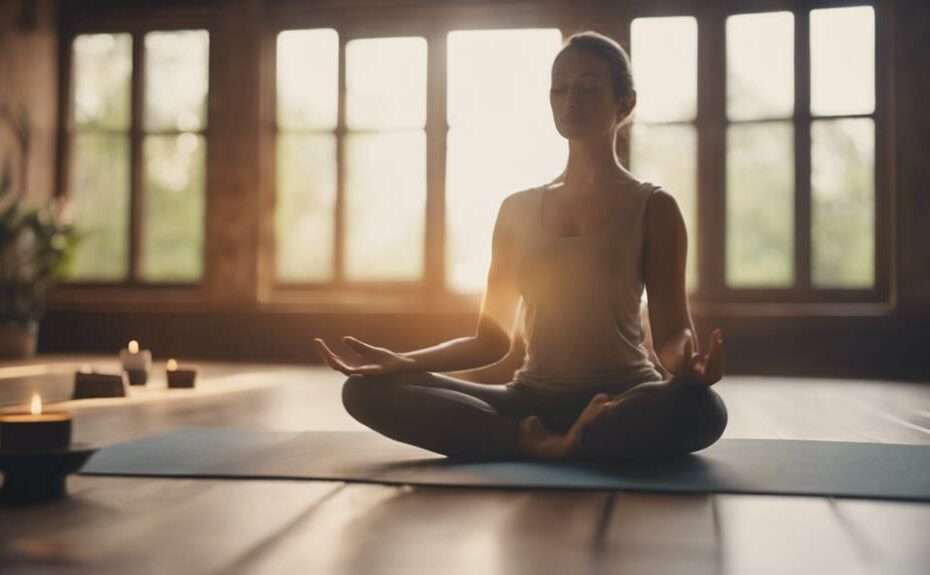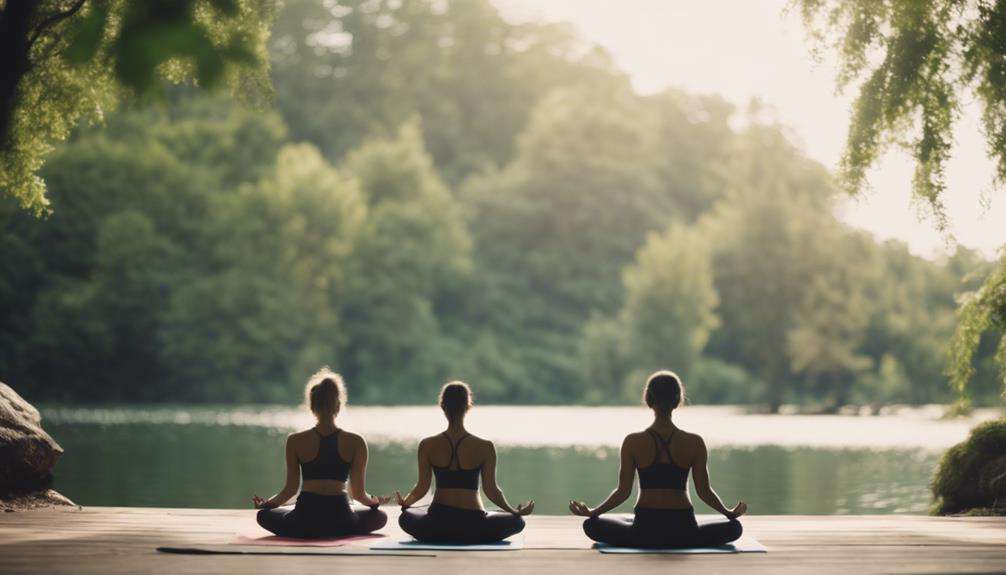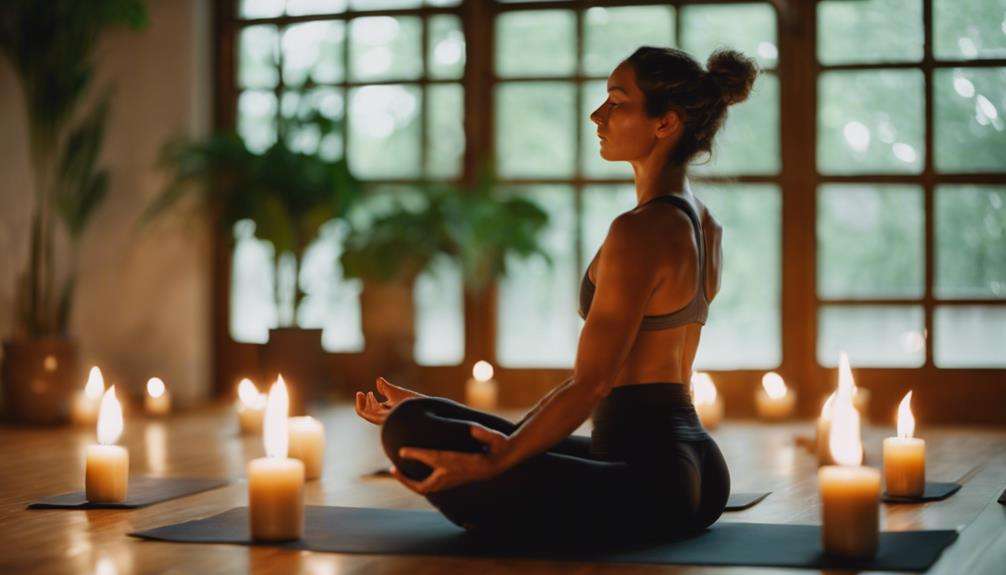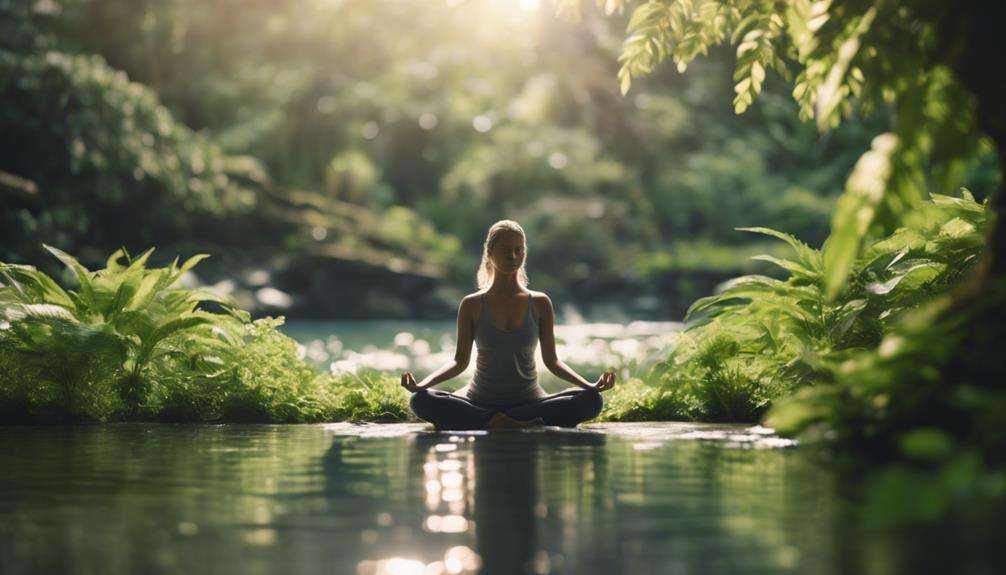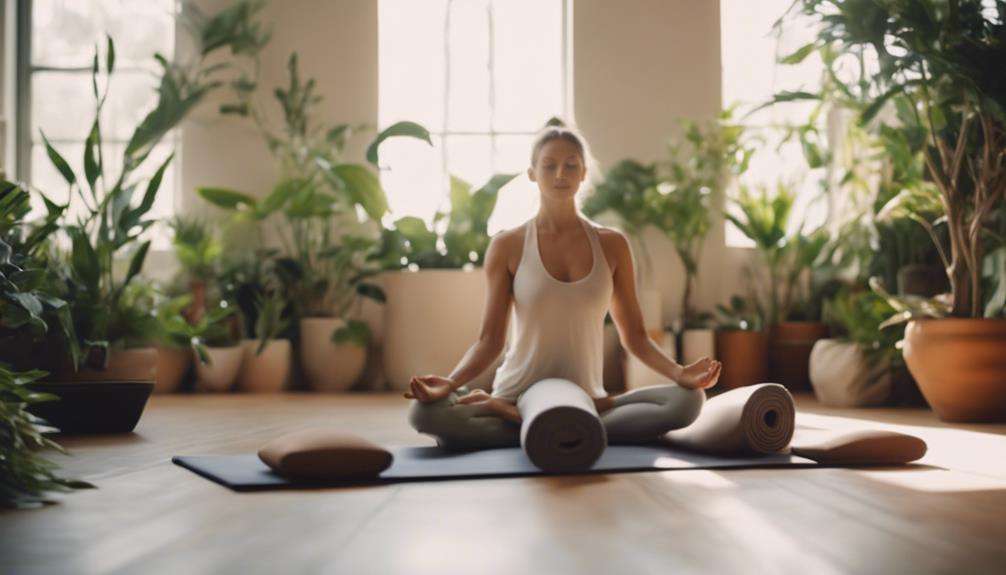You've probably heard about the benefits of mindfulness in yoga and meditation, but where do you start? From simple breathing techniques to mindful movement practices, there are numerous ways for beginners to kickstart their mindfulness journey.
But what about the lesser-known yet equally impactful mindfulness practices that can truly elevate your experience?
Stay with us to uncover the top 10 mindfulness techniques that are tailored for beginners in yoga and meditation, offering a comprehensive guide to deepen your practice and enhance your overall well-being.
Key Takeaways
- Stay fully present in the moment to enhance mindfulness in yoga and meditation.
- Deep breathing techniques promote calmness and focus, enhancing overall well-being.
- Engage in body-centered practices like body scan meditation for relaxation and stress reduction.
- Embrace mindful yoga poses to anchor in the present moment and reduce stress effectively.
Being Present in the Moment
Embrace the practice of staying fully engaged in the present moment during your yoga and meditation sessions. Mindfulness is the key to unlocking the benefits of these practices. By being mindful, you allow yourself to fully immerse in the experience, without letting distractions cloud your mind. In yoga and meditation, being present means acknowledging your thoughts, feelings, and bodily sensations without judgment.
Through mindful practice, you can cultivate a deeper sense of self-awareness. By focusing on the here and now, you can let go of worries about the past or future. This ability to be fully present can help reduce stress and enhance your overall well-being. Beginners can start by simply paying attention to their breath, body sensations, or the sounds around them. As you continue to practice being mindful during yoga and meditation, you'll develop a greater sense of clarity and peace in your daily life. Remember, each moment is an opportunity to practice mindfulness and nurture your inner calm.
Deep Breathing Techniques
As you explore deep breathing techniques, you'll discover a powerful tool to enhance your mindfulness practice.
By focusing on your breath, you can cultivate a sense of calm and presence in the moment.
Incorporating these techniques can help you center yourself and reduce stress effectively.
Benefits of Deep Breathing
Deep breathing techniques offer a multitude of benefits for beginners in yoga and meditation, enhancing relaxation, focus, and overall well-being. By engaging in deep breathing, you activate the parasympathetic response, which helps reduce stress and anxiety levels, fostering a sense of calmness.
This practice increases oxygen flow to your brain, boosting focus, concentration, and cognitive function during your sessions. Moreover, deep breathing can enhance your lung capacity, improve respiratory efficiency, and contribute to your physical wellness.
As you incorporate deep breathing into your routines, you release muscle tension, promoting relaxation and inner peace. This connection between your breath and body cultivates mindfulness, enriching your overall yoga and meditation experience.
How to Practice
Transitioning from understanding the benefits of deep breathing, let's now explore practical guidance on incorporating deep breathing techniques into your yoga and meditation practice.
Start by finding a quiet, comfortable space to sit or lie down. Close your eyes and begin taking deep breaths in through your nose, allowing your belly to rise as you fill your lungs with air. Focus on the sensation of your breath as you exhale slowly.
You can enhance your practice by incorporating body scans to bring awareness to each part of your body. Consider using guided meditations or mindfulness exercises to deepen your experience.
Body Scan Meditation Practice
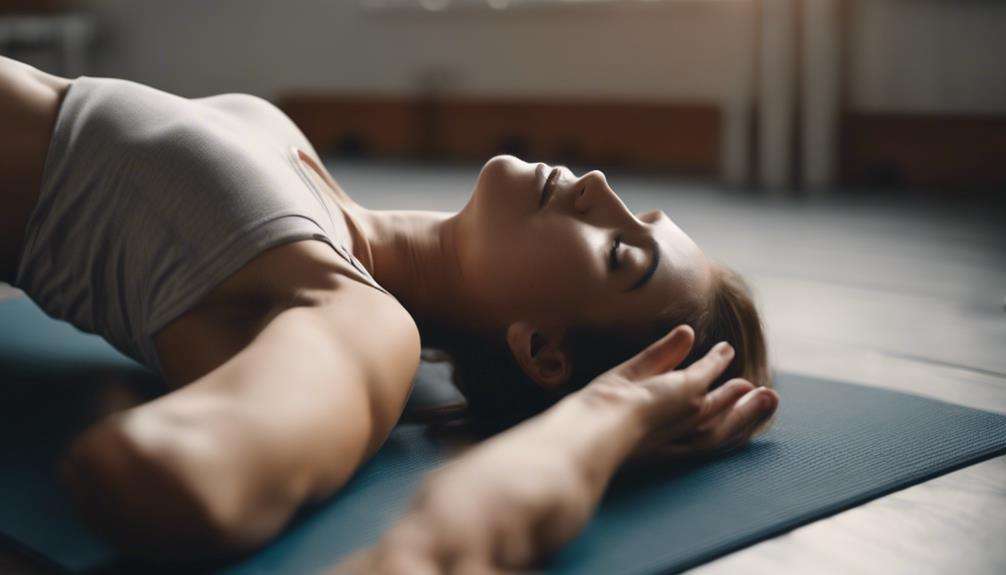
When beginning your journey into mindfulness practices, exploring the Body Scan Meditation technique can provide a gentle introduction to increasing awareness and relaxation throughout your body. This practice involves systematically focusing on different body parts to enhance self-awareness and promote relaxation.
Here are three key aspects to consider:
- Enhanced Awareness: By directing your attention to various body regions, you can become more in tune with subtle sensations, tensions, or discomfort that you may not have noticed before. This heightened awareness can help you identify areas of stress and learn to release them.
- Promotes Relaxation: Body scan meditation encourages a state of deep relaxation as you progressively move through each part of your body. By consciously relaxing different muscle groups, you can release built-up tension and experience a sense of calmness.
- Mindful Observation: This practice cultivates mindfulness by encouraging you to observe physical sensations without judgment. By simply noticing and acknowledging these sensations, you can develop a greater sense of presence and connection to your body.
Seated Meditation for Beginners
Embark on your mindfulness journey with seated meditation, a foundational practice for beginners in yoga and meditation that fosters awareness and inner calm through focused breathing or attention.
Seated meditation involves finding a comfortable position, sitting with a straight back, and gently closing your eyes. Begin by bringing your awareness to your breath, noticing the inhales and exhales without trying to control them. Allow your breath to guide you into the present moment, letting go of any distractions or thoughts that arise.
As you continue to focus on your breath or a chosen point of attention, you cultivate awareness of your inner state and surroundings. This practice enhances concentration, helping you develop a sense of inner calm and peace. Start with short sessions, gradually increasing the duration as you become more comfortable.
Seated meditation is a simple yet powerful technique that can support you in bringing mindfulness into your daily life.
Walking Meditation Tips

Consider incorporating walking meditation into your mindfulness practice to bring a sense of calm and focus to your movements and surroundings. Walking meditation involves taking slow, deliberate steps while paying close attention to your breathing and the environment around you. Here are some tips to enhance your walking meditation practice:
- Focus on Your Breath: Pay attention to the rhythm of your breath as you walk. Let each inhale and exhale guide your steps, creating a harmonious connection between your body and mind.
- Be Mindful of Your Surroundings: Notice the sights, sounds, and sensations around you as you walk. Stay present in the moment by observing the details of your environment without judgment.
- Embrace Deliberate Movements: Take each step with intention and awareness. Feel the ground beneath your feet with each stride, allowing the sensation of walking to anchor you in the present moment.
Incorporating these tips into your walking meditation practice can help you cultivate mindfulness in motion and deepen your overall sense of awareness.
Guided Meditation Sessions
If you're new to meditation, guided sessions with an experienced instructor can provide invaluable support. These sessions offer structured guidance on breathing techniques, body awareness, and relaxation methods to help deepen your practice.
Embrace the benefits of guided meditation for enhanced focus, reduced distractions, and a more fulfilling mindfulness experience.
Benefits of Guided Meditation
For beginners exploring mindfulness practices, guided meditation sessions offer a valuable opportunity to learn and cultivate meditation techniques with structured support from experienced instructors. Guided meditation is particularly beneficial for beginners as it provides a foundation for building a sustainable meditation practice. Here are three key benefits of guided meditation for beginners:
- Enhanced Focus: Guided meditation helps beginners stay focused by providing verbal cues and instructions throughout the session.
- Stress Reduction: Beginners can experience reduced stress levels through guided meditation, promoting a sense of calm and relaxation.
- Improved Mental Health: Engaging in guided meditation can lead to improved mental health outcomes for beginners, such as reduced anxiety and enhanced emotional well-being.
Tips for Effective Guidance
To maximize the benefits of guided meditation sessions, focus on actively engaging with the instructions and visualizations provided by experienced practitioners. By practicing mindfulness techniques and following the structured guidance offered, you can improve your focus and deepen your meditation experience.
Remember to listen attentively to the verbal cues and prompts given during the session, allowing yourself to fully immerse in the practice. Embrace the opportunity to let go of distractions and connect with your inner self through the guidance provided.
Research supports the effectiveness of guided meditation in reducing stress and enhancing overall well-being, making it a valuable tool for beginners. Trust in the process and allow yourself to be guided towards a more profound state of mindfulness.
Morning Mindfulness Routine
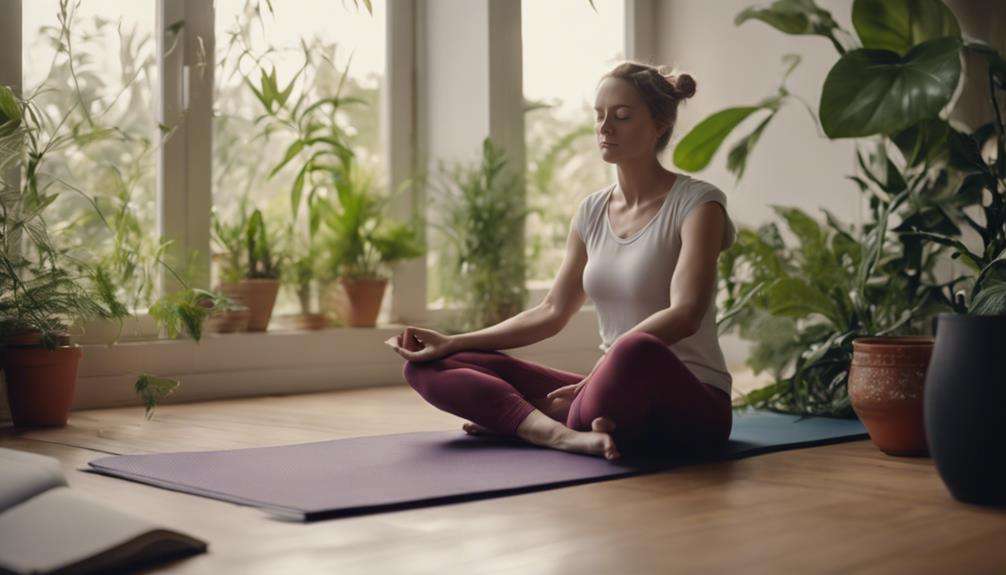
Start your day with a refreshing morning mindfulness routine to enhance self-awareness and set a positive tone for what lies ahead. This routine is a powerful way to connect with your body, focus your attention, and cultivate mindfulness from the moment you wake up. Here are three essential practices to include in your morning mindfulness routine:
- Mindful Breathing: Take a few minutes to sit quietly and focus on your breath. Notice the sensation of each inhale and exhale, allowing your breath to anchor you in the present moment.
- Full-Body Scan: Conduct a full-body scan to check in with each part of your body. Start from your toes and work your way up, noticing any areas of tension or discomfort. This practice can help you become more attuned to your physical sensations.
- Practicing Mindfulness: Engage in a short meditation or mindfulness exercise to center your mind and set a positive intention for the day. Focus on being present and nurturing a sense of calmness within yourself.
Incorporating these practices into your morning routine can help you start your day with clarity, focus, and a deeper connection to yourself.
Mindful Exercise and Workouts
Enhance your workout experience by incorporating mindfulness practices that focus on body sensations and breathing, promoting a deeper mind-body connection. By paying attention to the present moment during exercise, you can reduce distractions and improve concentration. Mindful exercise involves tuning in to how your body feels as you move, noticing the sensations with curiosity and without judgment. This awareness of body sensations can help you connect more deeply with your physical self, fostering a stronger mind-body connection.
Engaging in mindful movement during workouts can also assist in reducing stress and promoting relaxation. By staying present and fully experiencing each movement, you can increase self-awareness and emotional well-being. This practice not only benefits your physical health but also nurtures your mental and emotional wellness. As you integrate mindfulness activities into your exercise routine, you may find a sense of calm and balance that transcends the physical benefits, leading to a more holistic approach to fitness and overall well-being.
Mindful Yoga Poses

By integrating breath with movement, mindful yoga poses offer a transformative practice that enhances present-moment awareness and deepens your body-mind connection. Practicing mindful yoga poses can be a powerful way to cultivate body awareness, focus on the present moment, and reduce stress through the integration of breath flow and movement.
Here are three key aspects of mindful yoga poses:
- Body Awareness: Mindful yoga encourages you to tune into your body, notice any tensions, and make adjustments to find comfort and alignment in each pose.
- Present-Moment Awareness: By focusing on the breath and sensations in the body during yoga poses like Cat-Cow, Downward Dog, and Warrior series, you can anchor yourself in the present moment and cultivate mindfulness.
- Mind-Body Connection: Through mindful yoga poses, you can strengthen the connection between your mind and body, leading to a greater sense of well-being and harmony. This practice can help calm the mind, reduce stress, and promote overall health and vitality.
Mindful Journaling for Beginners
Are you ready to embark on a journey of self-discovery through mindful journaling?
By dedicating a few moments each day to writing down your thoughts and emotions, you can cultivate a deeper sense of self-awareness.
Starting with simple prompts or free-form writing can help you kickstart this practice and reap the benefits of improved mental clarity and emotional well-being.
Benefits of Journaling
Journaling mindfully as a beginner can significantly boost your self-awareness and emotional well-being. By engaging in regular journaling, you can enhance your understanding of your thoughts and emotions, leading to a deeper level of self-awareness.
Acknowledging and processing your feelings through journaling promotes emotional well-being and mindfulness, helping you navigate through your inner experiences with greater clarity.
Moreover, journaling allows beginners to track their mindfulness journey, noting progress made and areas for improvement along the way. This practice serves as a therapeutic outlet for emotional expression, reducing stress and anxiety while fostering a sense of introspection and self-discovery.
- Enhances self-awareness through reflection on thoughts and emotions.
- Promotes emotional well-being by acknowledging and processing feelings.
- Allows tracking of mindfulness journey and provides a therapeutic outlet.
Getting Started Tips
To kickstart your mindful journaling journey as a beginner, begin by setting aside a few moments each day to reflect on your thoughts, emotions, and experiences without judgment. This daily reflection practice will help you develop self-awareness and cultivate mindfulness.
Start by jotting down your thoughts, feelings, and observations without analyzing them. It's essential to embrace whatever comes up in your journal without criticism. You can engage in mindful journaling at any time during the day that suits you best.
Journaling for Self-Awareness
Enhance your self-awareness journey through mindful journaling by dedicating daily moments to reflect on your thoughts, emotions, and experiences without judgment. Mindful journaling can be a powerful tool for beginners to deepen their understanding of themselves and cultivate mindfulness in their daily lives.
Here are three key aspects of mindful journaling for beginners:
- Track Patterns: Use your journal to identify recurring thoughts and emotions, helping you recognize patterns and triggers.
- Emotional Processing: Allow yourself to freely express and process your emotions on paper, promoting self-awareness and emotional regulation.
- Present-Moment Focus: Practice being in the present moment as you jot down your thoughts and feelings, fostering mindfulness and clarity in your daily life.
Start your journaling practice today to embark on a journey of self-discovery and personal growth.
Frequently Asked Questions
How to Do Yoga and Meditation for Beginners?
To start with yoga and meditation as a beginner, focus on breathing techniques, body awareness, gentle movements, visualization exercises, and relaxation techniques. Take it slow, listen to your body, and enjoy the journey of self-discovery.
How to Do Mindfulness Meditation for Beginners?
To start mindfulness meditation as a beginner, focus on your breath for calmness. Notice body sensations. Try guided meditations for help. Incorporate mindful movements. Practice daily for progress. It's about building awareness and peace within yourself.
What Is the Best Yoga Style for Mindfulness?
For the best yoga style that enhances mindfulness, try Hatha yoga. Its gentle pace, focus on breath, and meditation help cultivate mindfulness. Embrace the mind-body connection through slow movements, controlled breathing, and introspection.
How Do You Practice Mindfulness in Yoga?
To practice mindfulness in yoga, focus on mindful breathing, body awareness, and being in the present moment. Engage in gentle movements with inner focus, observing thoughts without judgment. Connect mind, body, and breath for a holistic experience.
Conclusion
As you embark on your mindfulness journey through yoga and meditation, remember that every moment you spend practicing is a step towards greater peace and presence.
Did you know that research shows mindfulness practices can reduce symptoms of anxiety and depression by up to 50%?
Keep embracing the present moment, deep breathing, body awareness, and mindful movement to enhance your overall well-being.
You're on the right path – keep going and trust the process. You've got this!
